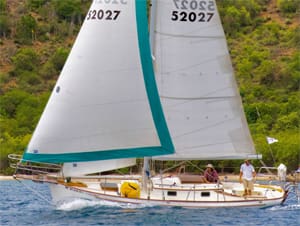Paul Exner applies his 40-plus years of sailing experience as a leader of sail-training expeditions aboard his self-built Cape George Cutter 31, Solstice, in the oceanic waters off the Hawaiian islands, and provides ocean sea trial and vessel operation curriculum services to boat owners wishing to master and prepare their vessels for ocean passages. Paul is a master sailing coach for private individuals and adventure seekers, and draws his knowledge from vast practical experience with oceangoing boats. His website is www.moderngeographic.com.
Ocean Navigator: In your experience, what are the major elements that an offshore boat needs?
Paul Exner: A good offshore boat must provide the sailor a balance of elements that satisfies their affinity for passagemaking by deciding between various tradeoffs: 1) strength vs. speed (hull, superstructure and sailing rig); 2) robust mechanical systems; 3) layout for short-handed operation underway (ergonomic design to operate running rigging while living aboard comfortably below deck); 4) sail inventory (to handle a variety of wind); 5) piloting and navigation systems (autopilot, chartplotter and other instrumentation); and 6) electric power management.
Strength vs. speed: Personally, I favor strong boats that are also fast — a combination that can pose a challenge. A strong boat that’s heavy is not practical to operate on a passage without a big expense on large, powerful systems with layers of redundancy, nor is it simple to prepare and maintain for ocean work. Instead, speed and performance is very important because I’d prefer the option to navigate around bad weather using an optimized sailing design to sail where I want, rather than hunker down in a gale for days aboard a heavy boat.
Robust mechanical systems: A good hull must be supported by robust mechanical systems for steering and running rigging. In my experience, the desirable elements of a reliable offshore boat’s mechanical steering system should first be vertical structural support, and then rotational reliability. Aboard my Cape George cutter, with the rudder completely supported vertically from transom to full keel, I never worry about the rudder! The solid bronze pintles and gudgeons attach the rudder to the boat from top to bottom. They’re bushed with high-quality polymer inserts set into the gudgeons, can easily be inspected and have not worn out despite 16 years of heavy ocean work.
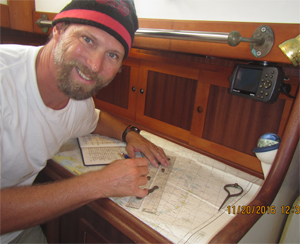 |
|
Paul Exner at Solstice’s nav station. |
Ergonomic layouts: Ergonomic layouts for cockpits and interiors that make it physically easier to manipulate running rigging while sailing, or improve comfort below deck offshore, are desirable elements. Crew fatigue is the number-one struggle facing offshore sailors, as physical demands on their strength and diet take an accumulative toll. The option to upgrade some equipment aboard new offshore boats is crucial for items like winches, autopilots, boom vangs, galleys and sea berths.
Sail inventory: Every sailing vessel going offshore must have sails in serviceable condition — even better if they have an efficient shape by a reputable designer. There’s typically not space aboard offshore cruising boats to carry a complete inventory of sails for every wind condition and sailing angle, which means we must be selective. First and foremost, the mainsail must be in good condition and reefable for use in 40 to 45 knots of wind, plus a storm trysail. This means the mainsail must have a deep third reef; despite what anyone tells you to the contrary, this point is essential. In-mast furlers are fantastic and reliable offshore tools, as the sail area can be micro-adjusted. Sometimes during the passing of a strong cold front offshore, I’ll deploy just a couple feet of in-mast furled mainsail so I can sail the boat safely forward at 5 knots. I still recommend having the provision to fly a trysail if you carry in-mast furling. Roller-furling headsails are the norm, although I still use a hank-on system aboard my boat for her staysail, and a furler to manage her headsails flown from the bowsprit.
Piloting and navigation systems: Piloting boats offshore is the practical side of seamanship I enjoy most; getting from A to B while managing the entire vessel is stimulating and highly rewarding. Sometimes I’m so “dialed-in” to operating a boat offshore that I happily focus solely on that and think of nothing else. But, the planning, experience and optimization techniques I use took me decades of practice to attain. I always pilot offshore with an objective in mind, an ultimate or intermediate destination. Basically I manage the boat based on my course over ground as given by my GPS, and I compare my COG to my boat’s heading when she’s sailing in the groove to make inference about currents or leeway. In this manner I can also tell if I can glean more efficiency from the setup by studying how she behaves in the given sea state and wind speed.
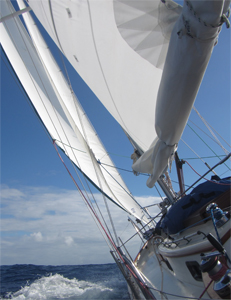 |
|
Solstice at sea with a reefed main. |
The piloting systems that enable me are a magnetic compass, GPS position, COG, SOG, electronic autopilot feedback from fluxgate compass or wind vane servo (or the feedback from a mechanical wind vane if in use), AIS, radar, hand-bearing compass and depth sounder. I also plot regular fixes on my oceanic charts, make log entries and download info from communications systems, including weather forecasts. As a skipper, I’m also caring for the crew and making sure we eat and sleep. It’s a full-time job, and on expedition I’m also teaching my crew to do all the same tasks for themselves while experiencing a higher level of sailing.
However, the basic elements of piloting that I couldn’t do without are the magnetic compass, regular logbook entries, GPS latitude and longitude, dead reckoning, position plotting on paper charts, cloud observations, eyeball navigation and means of hands-free helming if short-handed.
Electric power management: Whether we go offshore with 200 amp-hours of house battery capacity or 2,000 amp-hours, we must have the ability to charge the battery banks somehow: engine-powered alternator(s), solar, wind, diesel generators and/or hydraulic generators — all of which are made efficient with sophisticated charging regulators, automatic charging relays, amp meter computers, shunting and redundant systems on the supply side.
ON: Your boat Solstice has a full keel. Why did you choose a vessel with that type of hull structure?
PE: Aesthetics, robustness of structure and bulletproof reputation are the characteristics of the full-keel design that molded my confidence to build/own one. I purchased a Cape George 31 bare hull in 1991. Serendipity played a role then, as I never imagined I’d acquire enough money to support my passion for boat ownership and sailing, so I embraced the idea that I’d build my own and do everything for the boat with my own hands, and the full keel seemed like the design that would make my dream attainable.
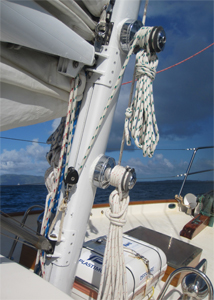 |
|
Solstice’s setup at the mast. |
Some sailors believe the notion that the full keel will “track” a straighter course than designs with shorter keels, and I’ve found this idea to be untrue as all boats yaw a lot in the ocean. In fact, I may argue that full-keeled vessels “track” worse than other designs, as there’s a larger underwater profile for overtaking waves to push around. What is true from my experience with full-keeled designs is that they’re more likely to sail themselves while keeping in the groove compared to designs with shorter keels. Since the full keel carries a larger proportion of weight in her ends (higher prismatic coefficient), they can certainly carry more sail area distributed over her length — hence the cutter rig with sails flown from the bow and bowsprit. And a mast positioned more forward in the hull, compared to sloops, allows for generally longer booms and larger mainsails. The entry and exit of the bow and stern respectively make for a kindlier hull that knifes into oncoming waves rather than “pound” like modern flat-bottomed hulls do. However, this characteristic also makes the hulls more susceptible to pitching, which ultimately slows boat speed and momentum — another reason a lot of sail area is required on a broader tacking angle to give the full-keeled vessel the raw punch to drive through waves.
ON: Can you explain why a cutter rig works best for you?
PE: It’s the cutter rig that’s necessary to propel the full-keeled hull. The trim between a full-keeled hull and cutter sail plan will create harmony and efficiency with the sea unlike any other design, but it’s not simple to attain.
Often misunderstood, the value of the cutter and full keel combo will be underappreciated and oversimplified in discussion by sailors who have little experience in these vessels. For example, one common statement made is, “Simply strike the yankee sail and sail under staysail and main when it blows.” This statement rarely presents itself true if you seek the full advantage of the cutter-rigged full keel. Though I have stricken the yankee completely in a blow (staysail too sometimes, leaving just a triple-reefed mainsail) and employed fore-reaching as a heavy-weather technique during a storm, the more probable scenario that showcases the advantage of the full-keeled cutter is where the mainsail and staysail are optimally trimmed to compliment one another to bring the full keel to maximum sailing efficiency, but the yankee remains under-trimmed and luffing 10 to 25 percent of its leading edge as I sail along under wind vane autopilot and wait for a large yaw to leeward by an infrequent but quantifiable wave. It’s at these moments that the main and staysail’s efficiency becomes stalled, but the under-trimmed yankee is now fully powered to enable the aerodynamic forces needed to accelerate the hull and allow the wind vane to once again bring the boat on the wind, where the complimentary trim between mainsail and staysail puts the boat back into its groove and on course!
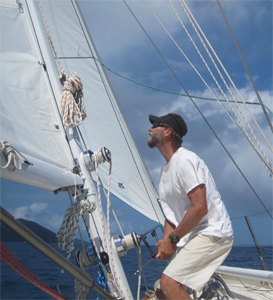 |
|
Exner handling a line. |
ON: How have you set up Solstice on deck (line leads, winches, stoppers, etc.) to work better as an offshore boat?
PE: I’ve rigged Solstice in a simple and straightforward manner to accommodate my affinity for short-handed sailing, and to improve reliability of the system by making all the components visibly inspectable and easily accessible should a hang-up occur, even at night.
All halyards and triple mainsail reefing can be accomplished single-handedly at the mast while Solstice is sailed by her wind vane autopilot. Three Lewmar 40 two-speed self-tailing winches are mounted to the mast (two on starboard, one on port). Mainsail reefing is performed on the starboard side of the mast, where one winch is dedicated to the mainsail’s halyard and the other starboard winch is used for the mainsail reefing control lines that exit the bottom of the boom at its forward end, which then are directed upward via snatch block to the other starboard-side winch. The reefing control lines can be cleated by line-stoppers located where the lines exit the boom at its forward underside. In this manner, I can easily reef from a single location on deck while maintaining a constant eye on every component of the system to notice a hang-up, should one occur. My position at the mast is also made safe because my distance from Solstice’s center of buoyancy is minimized since I stand at deck level and not atop a cabin house, as Solstice’s house is curtailed just aft of the mast. A standing position at the mast also provides the best ergonomic location to operate a winch compared to other boats’ winch layouts at the aft end of the cabin top, located under a short dodger where muscle leverage is hindered.
The second winch on the starboard side of the mast (non-mainsail halyard) is also used to operate the spinnaker and staysail halyard. All halyards stow conveniently coiled and hung on their winch, or above the line-stopper in the case of the spinnaker and staysail halyard.
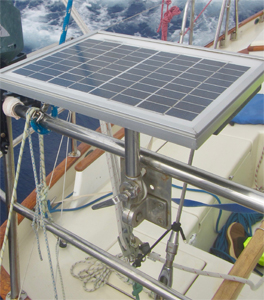 |
|
Solstice’s 15-watt articulating solar panel. |
The single portside mast winch is used for the two available yankee halyards and the mainsail topping lift, which doubles as a spare mainsail halyard. The two yankee halyards pass through line-stoppers and topping lift cleats to a horn cleat.
I designed Solstice’s halyard system and winch configuration myself while consulting Mike Feldman of Offshore Spars, who custom-fabricated Solstice’s spar for me. I specified redundancy in halyards and, to this day, after 16 years of hard ocean sailing aboard Solstice, I’ve always been able to fly the sails I wanted because a spare line was available to support my desire should I have a failure.
As a result of what’s configured at Solstice’s mast, only the staysail sheets occupy the cabin top, trimmed by dedicated port-and-starboard Lewmar 40 two-speed self-tailing winches. I sometimes also run the yankee furling control line to the starboard-side cabin-top winch. When the spinnaker is flying, I use the cabin-top winches to trim the spinnaker sheet. The spinnaker foreguy is also led to the windward cabin-top winch.
The cockpit of Solstice is “clean” underway, and only the actively controlled running rigging lives there. I installed two large Lewmar 48 two-speed self-tailing winches as her primaries for trimming the yankee sheet.
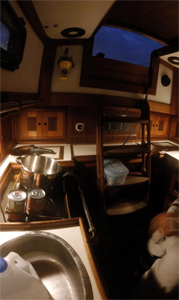 |
|
Solstice’s galley while underway. |
ON: Do you use a wind generator, water generator or solar panels for producing electricity offshore? Or do you rely on a genset or the main engine?
PE: Offshore, Solstice has two means of charging her house and cranking battery banks: 1) an alternator driven by the auxiliary diesel engine, and 2) a 15-watt solar panel on a custom articulating mount, regulated by a basic Flexcharge charge regulator designed to simultaneously charge my gel-type house bank and sealed lead-acid cranking battery.
I obtain excellent results from this simple system with a total house capacity of 200 amp-hours.
ON: What improvements would you make to Solstice and why?
PE: I designed and built Solstice from the perspective of a 25- to 35-year-old sailor because that’s how old I was during her construction. At the age of 52 now, and with thousands of bluewater miles sailed since her launch in 2002, I can only think of a few ways I’d improve Solstice without designing a completely different boat.
The following changes I plan to implement: 1) Improve Solstice’s anchoring system by going to all-chain anchor rode — 300 feet of 3/8-inch BBB. She presently has 65 feet of the same chain and 250 feet of 3/4-inch three-strand nylon. I believe an all-chain rode would not weigh down the bow as I initially thought. 2) I will also modify my recently upgraded manual windlass (Simpson Lawrence SeaTiger 555) by replacing the portside drum with a second gypsy to allow a second all-chain anchor rode to be available from the bow. 3) I will add a second 35-pound CQR anchor to the portside bow roller as an immediately accessible second anchor.
The addition of a watermaker would make Solstice a better offshore vessel. Her offshore crew of three would have plenty of water for daily showers, plus extra capacity for drinking. I really like the Spectra PowerSurvivor 40E, which draws 4 amps and produces 1.5 gallons of water each hour.

